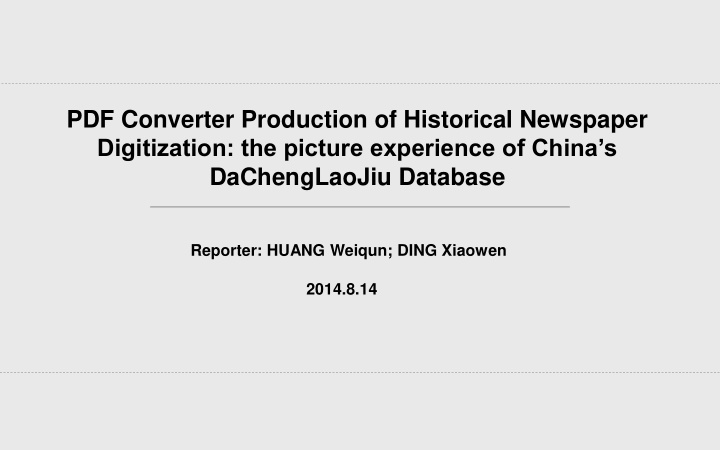



PDF Converter Production of Historical Newspaper Digitization: the picture experience of China’s DaChengLaoJiu Database Reporter: HUANG Weiqun; DING Xiaowen 2014.8.14
1. Introduction Content Historical 4. Newspaper 2. Survey Conclusion Digitization 3.Case study
1 Introduction
His istorical al new ewspape paper digitiz igitizati ation means the display of original historical newspapers, articles and pictures on screen via computer and web technology 2010 China’s DaChengLaoJiu 2011 Dazhong Daily historical newspaper digitalization 2012 the digitalization converter production in Beijing Company Survey Case study Conclusion Introduction
2 Survey
Chinese historical newspaper digitization projects Survey on Chinese historical newspaper digitization projects SURVEY DATE : 2014 -5-26 Company Image OCR Metadata Classified Full-text Cellphone capturing extraction indexing Database Tablet PC × × × DaChengLaoJi Single √ √ u layer Dazhong Daily Double √ √ √ √ √ layer Beijing Double √ √ √ √ √ Company layer × × √ × × National Single newspapers layer and periodicals index × Duxiu platform Double √ √ √ √ layer Survey Case study Conclusion Introduction
3 Case study
The cases of PDF format files production of Dazhong Daily and Beijing Company For the early historical newspapers, as there are no corresponding electronic files, so you need to make double layer or refactor the PDF. Double PDF production : 1.scanning images and processing them into compressed images of appropriate clarity which will be used as the upper image layer of double PDF; 2. rearranging the text according to the original layout structure to form the hidden lower text layer. Refactoring PDF uses images and text data to make the whole graphic mixed rearrangement according to the original layout structure, which is a single layer structure. Survey Case study Conclusion Introduction
Image scanning OCR Character Newspaper and recognition and checking modification proofreading Digital data Making format Layout analysis checking files and division Setting up Data double-platform warehousing retrieval system Survey Case study Conclusion Introduction
Double PDF , has two logistic layers(one is image layer and the other text layer). The upper layer is visible images for browsing (in order to control the file size, the picture layer is generally scanned images using high-definition compression format), which can show original scanned pages. The lower layer is a hidden text layer for text retrieval (not visible when browsed). Reconstructive PDF is a contemporarily popular single image-text structure. Differences
Reconstructive PDF Double PDF follow the way of today's rearranged according to the format original layout image-text rearrangement keep the perfect visionary 100% maintains scanned effect; text fonts may be layout visual effects; mosaic Visual browsing different from the original font. blur when enlarged support any enlarged font 100% maintains scanned printing with clear and smooth layout visual effects; mosaic printing edges, with no distortion and blur when enlarged blur, good print quality Differences
Reconstructive PDF Double PDF positioning and Support, slower Support, quicker retrieval 1/4 to 1/6, smaller than quicker opening and network storage capacity double layer PDF transmission be reflected in the text When there is a text layer text error rate retrieval and replication typo ,it can be seen directly Differences
Reconstructive PDF Double PDF suitable for viewing on the distribution suitable for viewing on the Internet, mobile phones, channels local computer and local area tablet PCs, local computer and network local area network album producing meet the individual needs meet the individual needs 15% ~ 20% higher than the Cheaper than reconstructive double PDF due to the costs PDF relatively large production work If to further meet the needs of format searching and PDF browsing , double-PDF technology should be adopted; If considering the application of future media terminal (such as Apple's iPhone, iPad tablet PCs), the development of more derivative products, reconstruction of PDF technical solutions should be adopted. Differences
4 Conclusion
problems rough original newspaper printing technology the history of the type of information the original printing technology, nonstandard font sizes low recognition rate of the historical newspaper resources, thus artificial processing is needed. higher human resources and financial costs, and technological breakthroughs meaning are on a broader level exploring. respect to history protection of historical data mining of data value the spirit of social responsibility and cultural innovation, co- existence of protection and development, and the librarians’ responsibility Survey Case study Conclusion Introduction
Recommend
More recommend